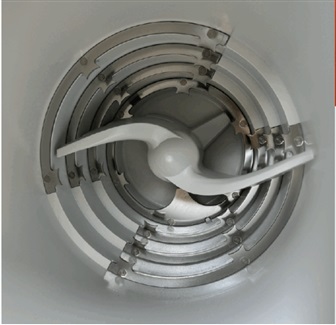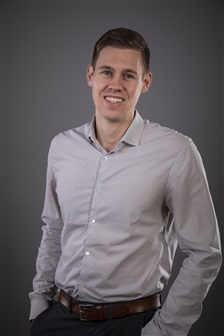Food Cycle Science, a Canadian company based out of Ottawa, Canada, is behind the FoodCycler, an innovative on-site food waste recycling appliance that deals with food waste from the convenience of one's home. Through several innovative designs and its groundbreaking Vortech technology, the FoodCycler allows customers to greatly reduce the amount of food waste by turning leftovers into a nutrient-rich soil additive, all the while reducing greenhouse gas emissions by up to 95%.
In an interview with DIGITIMES Asia, Alex Hayman, VP of Business Development for Food Cycle Science, stated that the company believes that "when you marry convenient solutions with environmental solutions, that's a great way to help enact change." He pointed out that as the public becomes more aware of climate change, the company has seen a lot of growth. For instance, in November 2022, partnering with a local distributor, the Axiom Store, it completed a very successful crowdfunding campaign in Taiwan.
Founded in 2011, Food Cycle Science started as a North American distributor of large-scale food waste machines used in places like hotels and casinos and has continued to do so today. Around 2016, the company began to self-design and manufacture countertop models. The result was the FoodCycler. The company has since made some aggressive hiring plans to expand from its current size of around 50 employees to between 70 to 100 employees by the end of 2023.
The innovative Vortech technology
Food waste processing machines have been around for some time already. What makes the FoodCycler stand out amongst its competitors is the company's innovative Vortech technology. With this technology, the FoodCycler became the only device on the market capable of breaking down "hard" food wastes like bones, high-fiber fruit and vegetable peels, and seafood shells.
The Vortech technology consists of several components that each play a role in allowing the FoodCycler to handle hard food wastes and have the largest capacity on the market. These include the curved turbine blades with a large contact area, the crusher with a multi-layer serrated design, and the food waste bucket with a cone-shaped bottom.
During R&D, Food Cycle Science discovered that in order to increase the device's processing capacity, simply making the bucket bigger won't be enough. The device needs to process food waste more efficiently. Therefore, they designed a curved turbine blade with a large contact area which produces a finer and more even grind. It's also able to churn the food waste up and down, further increasing the grinding area. This increased efficiency gave the FoodCycler a 5-liter capacity, the largest on the market.

Photo: The turbine blade.
Credit: Food Cycle Science, the Axiom Store
Paired with the large turbine blade is a multi-layer circular serrated design crusher inspired by a hippo's teeth. These "teeth" can easily crush hard food waste that is not processible by other devices. It allows users to skip the step of cutting food waste into smaller pieces before throwing them into the device.

Photo: The multi-layer crusher.
Credit: Food Cycle Science, the Axiom Store
Last but not least, the base of the bucket is cone-shaped to prevent starches (e.g., rice and bread) and high-sugar content food waste (e.g., fruit peels) from sticking to the bottom. This not only makes the bucket easier to clean but also allows for a more thorough grind, as the food waste can be more easily moved around and crushed compared to a flat bottom.
An environmentally friendly way to process food waste
Besides reducing the volume of food waste, the FoodCycler is also a more environmentally friendly alternative to the usual method of processing food waste, which is to dump it in landfills. Hayman pointed out that when food waste is placed in a landfill, it breaks down anaerobically, or without oxygen. When that happens, it produces methane gas, one of the most polluting greenhouse gas, typically about 25 times more damaging than CO2.
What the FoodCycler does is, for one, take food waste out of landfills, thus removing the production of methane gas. The other thing is that it processes the food waste in an oxygen-rich environment by heating and using a grinding mechanism to force oxygen through the food waste. This ensures that zero methane gas is created during the process. This is why they can reduce greenhouse gas emissions by 95%.
The latest model of the FoodCycler device has also switched to a modular design. Thus, if anything breaks in the device, it's easy to repair. An easy repair means you don't need to throw out the entire machine when something breaks down, thus reducing overall waste. "We're trying to make a device that reduces waste, not creates more," Hayman stated.
Expansion to more markets
With several products already available on the market and having been around for more than a decade, Food Cycle Science is not a typical startup. Hayman admitted that the company is certainly exiting its startup phase. However, they want to keep the startup mindset as they pivot and adapt to new markets and opportunities, "we called it an agile but rapidly growing startup-like environment," he stated.
The company's next step is to expand to more countries worldwide. They form strategic partnerships with local distributors to leverage the distributors' brand recognition and relationships with retailers. For instance, they've collaborated with the well-known juicer brand Vitamix for the North American market. Hayman stated that they want to offer high-quality products and services that will make Vitamix proud to put its brand and logo on their products.
A similar strategy has already seen some success in other markets as well. Back in late November 2022, Food Cycle Science launched a crowdfunding campaign in Taiwan on the zeczec.com platform in partnership with the Axiom Store. The campaign was an overwhelming success, selling over 9000 FoodCycler machines within two months, making it the third-largest campaign ever on zeczec.com.
This is even more impressive since the FoodCycler is positioned on the market as a higher-end premium brand and is definitely not the cheapest product available. The good sales along with the higher prices allow the company to reinvest and add new technologies/features to all their different devices in the future.

Company logo

Photo: Alex Hayman, VP of Business Development at Food Cycle Science.
Credit: Food Cycle Science


